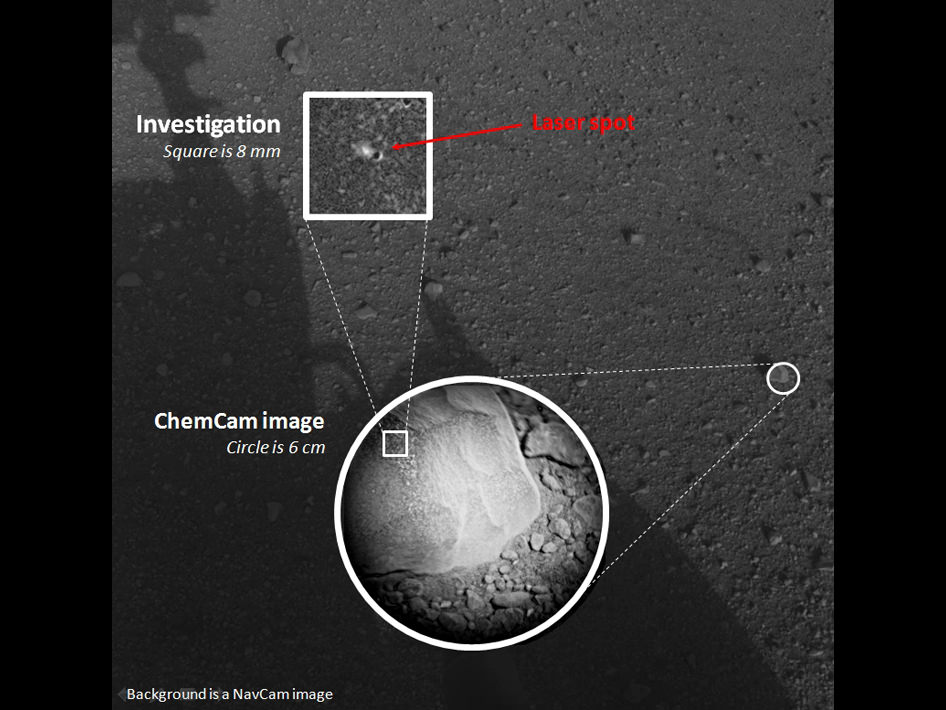Image Caption: PewPew !! – First Laser Zapped rock on Mars. This composite image, with magnified insets, depicts the first laser test by the Chemistry and Camera, or ChemCam, instrument aboard NASA’s Curiosity Mars rover. The composite incorporates a Navigation Camera image taken prior to the test, with insets taken by the camera in ChemCam. The circular insert highlights the rock before the laser test. The square inset is further magnified and processed to show the difference between images taken before and after the laser interrogation of the fist-sized rock, called “Coronation.” It is the first rock on any extraterrestrial planet to be investigated with such a laser test. ChemCam inaugurated use of its laser when it used the beam to investigate Coronation during Curiosity’s 13th day after landing. Credit: NASA/JPL-Caltech/LANL/CNES/IRAP
NASA’s Curiosity rover successfully blasted a Mars rock with a powerful laser beam, for the first time in history, today Aug. 19, inaugurating a revolutionary new era in planetary science with a new type of instrument that will deliver bountiful discoveries. The fist sized Martian rock zapped during the maiden laser target practice shots was appropriately dubbed “Coronation”.
The ChemCam instrument mounted at the top of Curiosity’s mast fired a total of 30 one-million watt pulses over a 10 second period at the 3 inch wide rock that vaporized a pinhead sized spot into an ionized, glowing plasma.
Each pulse lasted about five one-billionths of a second and was sufficient in energy to generate a spark of plasma to be observed with the ChemCam telescope and trio of spectrometers below deck in order to identify the elemental composition.
“Yes, I’ve got a laser beam attached to my head. I’m not ill tempered; I zapped a rock for science. PewPew,” tweeted Curiosity.
The NASA composite image above shows Coronation before and after the laser shots – watch out little Martians !
“We got a great spectrum of Coronation — lots of signal,” said ChemCam Principal Investigator Roger Wiens of Los Alamos National Laboratory, N.M. “Our team is both thrilled and working hard, looking at the results. After eight years building the instrument, it’s payoff time!”
Image caption: This mosaic shows the first target Curiosity zapped with the ChemCam laser, before being blasted on Aug. 19. The 3 inch wide rock was provisionally named N165 and is now called “Coronation”. Credit: NASA/JPL-Caltech/MSSS/LANL
ChemCam recorded spectra from the laser-induced spark during all 30 pulses at 6,144 different wavelengths of ultraviolet, visible and infrared light. The purpose of this test was target practice to make sure the laser could be precisely aimed and to characterize the instrument.
Ultimately the goal is use the laser to penetrate below the dusty surface and reveal the interior composition of the targeted rocks using the telescopic camera and spectrometers.
ChemCam, which stands for Chemistry and Camera, is a joint project between the US and France said Wiens at a news briefing on Aug. 17. “The science team is half French and half US.”
“It’s surprising that the data are even better than we ever had during tests on Earth, in signal-to-noise ratio,” said ChemCam Deputy Project Scientist Sylvestre Maurice of the Institut de Recherche en Astrophysique et Planetologie (IRAP) in Toulouse, France. “It’s so rich, we can expect great science from investigating what might be thousands of targets with ChemCam in the next two years.”
ChemCam is a remote sensing instrument and will get the most use of any of Curiosity’s instruments. It will be analyzing about 14,000 samples and help winnow down the targets and guide Curiosity to the most interesting samples for more detailed analysis, Wiens explained.
ChemCam uses a technique called laser-induced breakdown spectroscopy that has precedent in determining the composition of targets in other extreme environments such as inside nuclear reactors and on the sea floor, but is unprecedented in interplanetary exploration.
NASA’s 1 ton mega rover Curiosity is the biggest and most complex robot ever sent to the surface of another planet, sporting a payload of 10 state of the art science instruments weighing 15 times more than any prior roving vehicle. Curiosity’s goal is to determine if Mars was ever capable of supporting microbial life, past or present and to search for the signs of life in the form of organic molecules during the 2 year primary mission phase.



In H. G. Wells’ The War of the Worlds, it was the Martian war machines that used a “heat-ray” to vaporize the Earthlings!
We come in Peace.
(Shoot to Kill!)
“How to Serve Martians”… lol!
Destroy all does rocks. Who knows maybe a
Martians is hiding under it
Martians have moved to another galaxy, there is nothing worth blasting now, move on to a planet that has some moving targets worth shooting.
Curiosity: Uh, everything’s under control. Situation normal.
NASA control room: What happened?
Curiosity: Uh, we had a slight laser malfunction, but uh… everything’s perfectly all right now. We’re fine. We’re all fine here now, thank you. How are you?
NASA control room: We’re sending a manned mission up.
Curiosity: Uh, uh… negative, negative. We had a RTG leak here now. Give us a few months to lock it down. Large leak, very dangerous.
NASA control room: Who is this? What’s your AI license number?
Curiosity: Uh… [Shuts down the direct link communication.]
Curiosity: Boring conversation, anyway. OPPORTUNITY, WE’RE GONNA HAVE COMPANY!
GREAT reference! I literally chuckled!
Let’s not include any data in the report, that would be boring.
Can’t wait to see the scientific results from this first laser test! Viva la France! Long live the Republic de France!